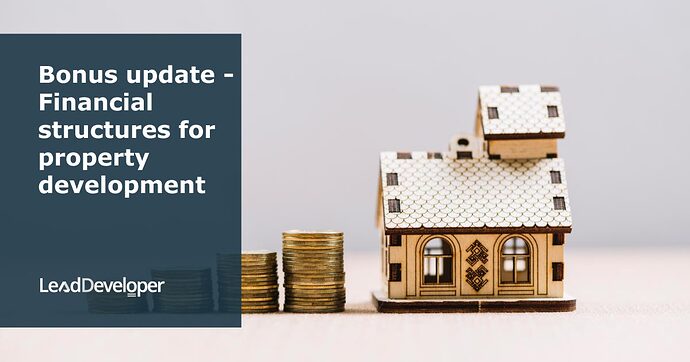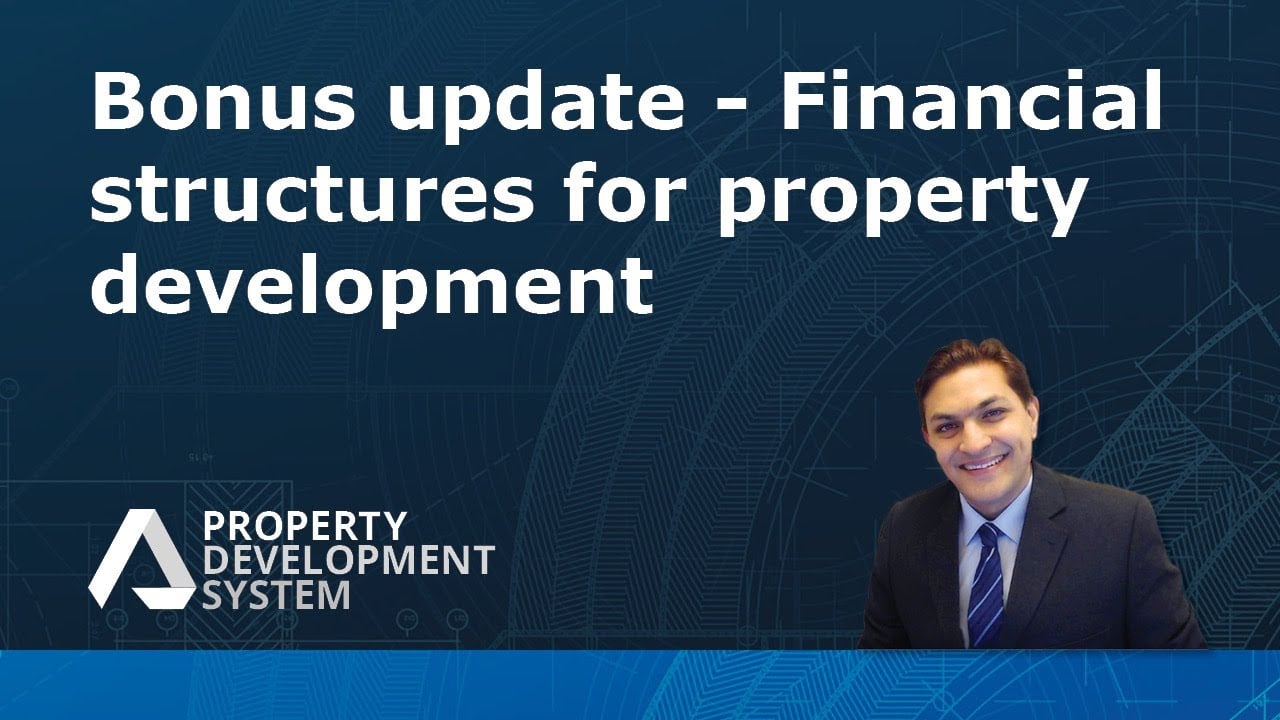Bonus Update - Financial Structures
Here, we discuss various financial structures for property development, focusing on their advantages disadvantages, and how they cater to different financial needs. You will learn the importance of seeking professional advice from accountants, lawyers, or financial planners.
Key Points:
Structures Overview
Various structures for property development are explored, including individual ownership, partnerships, companies, and trusts. Each structure has unique benefits and implications for tax, asset protection, and income distribution.
Individual Ownership
It is the simplest form and easiest to set up, but it has implications for tax based on total income and poses a risk for assets in case of lawsuits.
Partnerships
Offer a way to share income but require a split according to the partnership agreement. Assets of either partner may be subject to claims by creditors.
Companies
They are used for business operations with a fixed tax rate on profit. They provide some protection for shareholders but have specific disadvantages, including the immediate taxation of profits.
Trusts
Trusts are a popular structure due to their flexibility in income distribution and asset protection. They can be discretionary, unitary, or hybrid, with different rules on how beneficiaries’ income and capital gains are distributed.
Asset Protection and Tax Implications
Trusts offer a significant advantage in protecting assets from litigation and providing flexible income distribution to minimise tax liabilities. Learn the personal practices of using trusts for each property development project to safeguard assets and ensure optimal tax arrangements.
Professional Guidance
Emphasis on consulting with professional advisors to choose the appropriate structure tailored to individual financial goals and needs. The complexity of economic structures and their implications on tax, asset protection, and legal accountability necessitates professional input.
Insights Based on Numbers
Taxation
The impact of various structures on taxation, especially how individual ownership could lead to higher tax liabilities based on total income, is crucial. In contrast, trusts offer a way to distribute income in a manner that can reduce the overall tax burden.
Asset Protection
The number of properties or developments held within a specific structure can influence the level of asset protection. For example, each property can be held in a separate trust for enhanced protection.
Investment Scale
The choice between different structures may depend on the scale of the investment. For instance, large-scale developments might benefit more from a company structure due to the fixed tax rate on profits, whereas smaller projects might find trusts more advantageous.
Frequently Asked Questions
How does the choice of financial structure impact the overall profitability of a property development project?
The choice of financial structure can significantly impact the overall profitability of a property development project in several ways:
Tax Implications
Different structures have varied tax obligations. For example, individual ownership and partnerships might lead to higher tax liabilities based on the combined income of the owner or partners.
Companies are taxed at a corporate rate, which could be advantageous or disadvantageous depending on the profit margins and individual tax rates of the shareholders.
Trusts, particularly discretionary trusts, offer flexibility in distributing income to beneficiaries in lower tax brackets, potentially reducing the overall tax burden on the profits generated from the development.
Asset Protection
The structure chosen can affect the project’s financial health by protecting assets from potential lawsuits or creditors. Trusts provide a layer of protection not available to individual owners or partnerships, as the assets held in a trust are not considered the personal property of the beneficiaries.
This can safeguard the project’s assets and, by extension, its profitability from unrelated legal issues.
Operational Costs and Complexity
The operational costs and the complexity of managing the structure also play a role. Individual ownership might have lower operational costs but offers less flexibility and protection.
Trusts and companies come with higher setup and maintenance costs but offer benefits in tax optimisation and asset protection that can lead to higher net profitability.
Flexibility in Investment and Development Opportunities
The structure choice can influence the project’s ability to attract investment or partners. Trusts and companies, for example, might be more attractive to potential investors due to the clear separation of project assets and liabilities from personal assets.
This can lead to more significant investment opportunities, potentially increasing the project’s scale and profitability.
What are the benefits of using a trust over a company structure for small to medium-scale property development?
Tax Efficiency
Trusts offer significant tax advantages due to their ability to distribute income among beneficiaries in a way that minimises the overall tax burden. Unlike companies, which are taxed at a flat corporate rate before distribution, trusts can allocate profits directly to beneficiaries, who may be taxed at lower personal income tax rates.
This flexibility can result in considerable tax savings, particularly for small to medium-scale projects where the ability to distribute profits strategically can make a more significant difference in the project’s net profitability.
Asset Protection
Trusts provide superior asset protection compared to companies. Assets held within a trust are protected from the personal liabilities of the beneficiaries, meaning that in the event of legal action against a beneficiary, the assets within the trust are generally not at risk. This level of protection is crucial for property development, where the legal and financial risks can be significant.
Flexibility in Income Distribution
Trusts, especially discretionary trusts, allow for the flexible distribution of income and capital gains among beneficiaries. This flexibility can be used strategically to distribute income to beneficiaries in lower tax brackets or to manage the flow of income in a way that aligns with the beneficiaries’ financial goals and needs.
Such flexibility is unavailable in company structures, where profits are distributed to shareholders based on their shareholding percentages and are taxed at the corporate rate before distribution.
Estate Planning and Succession Benefits
Trusts can be structured to provide benefits for estate planning and succession, ensuring that the development project can be passed on or managed according to the settlor’s wishes in the event of their death or incapacity.
This feature particularly benefits family-owned development projects, where long-term management and ownership are considered.
What are the main types of financial structures used in property development?
The primary financial structures include individual ownership, partnerships, companies, and trusts. Each has distinct characteristics affecting tax, asset protection, and income distribution.
What are the key features and drawbacks of individual ownership?
Individual ownership is straightforward to establish but has significant drawbacks, such as higher tax liabilities based on total income and increased risk to personal assets in case of legal action.
How do partnerships work in property development, and what are their risks?
Partnerships allow income sharing between partners according to a pre-agreed partnership agreement. However, they expose each partner’s assets to potential claims by creditors, which can be a considerable risk.
What advantages and disadvantages do companies offer in property development?
Companies are favoured for their fixed tax rate on profits and protection for shareholders’ personal assets. However, they face disadvantages like the immediate taxation of profits, which can impact cash flow and reinvestment opportunities.
Can you explain the benefits of using trusts in property development?
Trusts, including discretionary, unitary, or hybrid, are popular due to their flexibility in income distribution and substantial asset protection benefits. They allow for strategic tax planning and safeguarding assets from litigation.
How do trusts provide asset protection and tax benefits?
Trusts protect assets from litigation by separating ownership, making them harder to target in legal disputes. They also offer flexible income distribution options, which can be used to minimise tax liabilities effectively.
Why is professional advice essential when choosing a financial structure for property development?
Due to the complexity of financial structures and their varied implications on tax, asset protection, and legal responsibility, consulting with accountants, lawyers, or financial planners is crucial to tailor the structure to your specific financial goals and needs.
How does the financial structure impact taxation in property development?
The structure can significantly affect tax liabilities. For instance, individual ownership might result in higher taxes due to income inclusion in personal taxes, whereas trusts can distribute income to minimise the overall tax burden.
How does the choice of structure relate to the scale of the investment?
The scale of the investment often dictates the most beneficial structure. Large-scale projects may benefit from the corporate structure’s fixed tax rates, while smaller investments might find the flexibility of trusts more advantageous.
What role does asset protection play in selecting a financial structure?
Asset protection is a critical consideration, especially in segregating each property or development to shield it from potential legal challenges. Trusts, for instance, offer enhanced protection by holding each property in a separate entity, making it difficult for creditors to access all assets.
Test Your Knowledge
1. What is the primary advantage of using individual ownership for property development?
A) Lower tax liabilities
B) Flexibility in income distribution
C) Ease of setup and simplicity
D) Enhanced asset protection
2. How do partnerships in property development typically distribute income?
A) Equally among all partners
B) Based on the fixed tax rate
C) According to the partnership agreement
D) Through discretionary distributions
3. What tax rate applies to companies in property development?
A) A variable rate based on each shareholder’s tax bracket
B) A fixed tax rate on profit
C) No taxation until profits are distributed
D) Progressive tax rates based on income levels
4. Which financial structure provides the most flexibility in income distribution and asset protection?
A) Individual Ownership
B) Partnerships
C) Companies
D) Trusts
5. Why is professional advice crucial when selecting a financial structure for property development?
A) To ensure the highest possible tax rate
B) To comply with international property laws
C) To tailor the structure to individual financial goals and needs
D) To simplify the investment process
6. How can the choice of financial structure impact the overall profitability of a property development project?
A) It has no significant impact
B) By influencing operational costs and complexity
C) Through the color scheme of the development
D) By determining the location of the property
7. Which of the following is a significant tax advantage of using trusts for property development?
A) Trusts are exempt from all forms of taxation
B) Ability to distribute income to minimize overall tax burden
C) Fixed tax rate on profits regardless of amount
D) No need to distribute profits annually
8. In the context of asset protection, why might each property be held in a separate trust?
A) To simplify tax reporting
B) To increase the fixed tax rate benefits
C) For enhanced protection from litigation
D) It is a legal requirement
9. Which financial structure is particularly advantageous for large-scale property development due to its fixed tax rate on profits?
A) Individual Ownership
B) Partnerships
C) Companies
D) Trusts
10. What factor is crucial in deciding between different financial structures for property development?
A) The color preference of the developer
B) The scale of the investment
C) The developer’s nationality
D) The current phase of the moon
Answers:
- C) Ease of setup and simplicity
- C) According to the partnership agreement
- B) A fixed tax rate on profit
- D) Trusts
- C) To tailor the structure to individual financial goals and needs
- B) By influencing operational costs and complexity
- B) Ability to distribute income to minimize overall tax burden
- C) For enhanced protection from litigation
- C) Companies
- B) The scale of the investment
Assignment
Practical Assignment on Financial Structures in Property Development
Objective:
This assignment is designed to deepen your understanding of the different financial structures available for property development, their advantages, disadvantages, and suitability based on various criteria such as tax implications, asset protection, and the scale of investment.
Instructions:
Complete the tasks below, which include analytical questions, practical exercises, and research questions. This assignment requires you to apply the concepts discussed regarding financial structures in property development.
Part 1: Analytical Questions
Compare and Contrast:
Write a comparative analysis of at least 300 words on the four main financial structures for property development (individual ownership, partnerships, companies, trusts), focusing on their tax implications, asset protection, and income distribution aspects.
Scenario Analysis:
Given a scenario in which a property developer faces potential lawsuits, which financial structure would provide the best asset protection? Justify your answer with references to the concepts discussed.
Part 2: Practical Exercises
Draft a Partnership Agreement:
Create a mock partnership agreement for a property development project. Include clauses on income distribution, asset protection, and procedures in the event of a partner wanting to exit the partnership.
Design a Trust Structure:
Outline an essential structure for a discretionary trust intended for a small-scale property development project. Specify how income distribution might be managed to minimise tax liabilities and protect assets.
Part 3: Research Questions
Taxation Research:
Investigate and summarise the tax rates applicable to companies and trusts in your jurisdiction. Discuss how these rates impact the choice of financial structure for property development projects.
Case Study:
Find and summarise a real-world example of a property development project that utilised a trust structure. Discuss the benefits and any challenges encountered due to this financial structure.
Deliverables:
- A comprehensive report includes your comparative analysis, drafted documents, and research findings. Make sure to reference any external sources you consult properly.
- A case study analysis that explores the practical application of a trust structure in real-world property development.
Submission Guidelines:
- Submit your report and case study as a single document in PDF format.
- Ensure your work is clearly organised, with each section and question labeled appropriately.
- Include a bibliography or reference list for all sources and materials used in your research.



